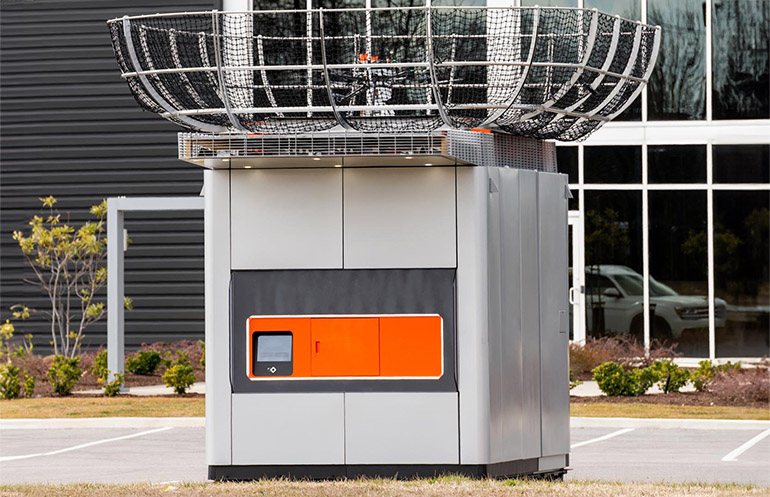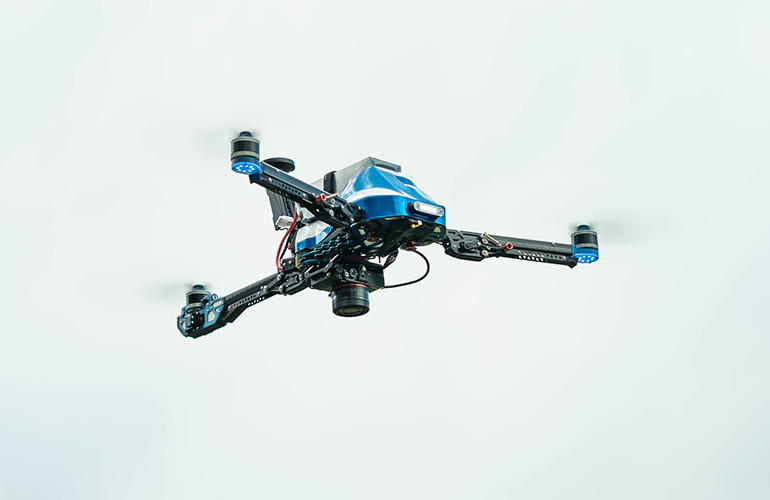DroneUp said its ecosystem can perform deliveries for retail stores, QSRs, medical organizations, college campuses, and more. Source: DroneUp
DroneUp LLC last week announced that it has completed 500 deliveries in a single day. In addition to increasing the number of flights to reach this milestone, the company said it has improved the pilot-to-drone ratio required to safely accomplish each flight.
“We are excited about this achievement, but it’s only the beginning of what’s possible,” stated Tom Walker, CEO of DroneUp. “Our work in driving volume while ensuring the reliability and safety of our system is ongoing.”
“Coordinating package loading, energy management, and safety are [not only] critical, but also challenging to scale,” he added. “Our team has optimized ground logistics to ensure that we can maintain high delivery volumes without compromising on safety or efficiency and, most importantly, drive costs down.”
Founded in 2016, DroneUp said its proprietary technology integrates with ground infrastructure to provide affordable last-mile delivery services to a growing number of locations across the U.S. The Virginia Beach, Va.-based company also said its Uncrew proprietary software enables users to manage missions from anywhere.
DroneUp develops autonomy capabilities
“The key to a sustainable drone delivery industry is to achieve a scale that’s feasible for commercial sellers while meeting customers’ increased demands,” said DroneUp.
The company performed capacity testing at its research and development facility at Richard Bland College (RBC) of William & Mary on behalf of its commercial partners. Its team used a waiver from the Federal Aviation Administration for beyond visual line-of-sight (BVLOS) operations.
DroneUp said its researchers have focused on automating deliveries and accomplished the following:
- Increased deliveries: The company has reached 40 deliveries per hour, carrying up to 10 lb. (4.5 kg) weight capacity.
- Improved pilot-to-drone ratio: The tests achieved a one-to-many operator-to-drone ratio, which aids in driving down the cost of delivery for DroneUp’s partners.
- Software for mission planning, management: The cloud-based Uncrew uses real-time geodata from uncrewed aircraft system (UAS) traffic management, or UTM, for accurate airspace, terrain, and traffic information. It generates automated mission plans from HubOps mission requests, allowing operators to safely and efficiently oversee up to 20 concurrent missions through a unified interface.
DroneUp has focused on integrating its products into a single platform for last-mile logistics. In March, the company introduced its technology ecosystem, which includes the DBX destination box on the ground, aerial drones, and its autonomy software.
“At the same time as the FAA begins to open air space for simultaneous drone deliveries, our ecosystem has been through its own rigors of testing and is ready to meet the moment,” said Walker. “Its proven design makes the economics of drone delivery feasible for retailers while providing intuitive accessibility that brings unprecedented convenience to end users.”

The DroneUp ecosystem includes the DBX ground station for drone deliveries. Source: DroneUp
The path to 500 daily deliveries
Not only is DroneUp rapidly increasing its delivery capacity, but it’s also keeping its customers happy and coming back for future purchases.
The company recently surveyed customers who used drone delivery in Q4 2023. It found that drone delivery earned over 90% positive ratings on having packages arrive safely, on time, and in perfect condition.
Retailers reported that drone delivery is driving incremental purchases. Thirty-six percent of survey respondents acknowledged that they found additional items to add to their carts.
DroneUp said it continues to move toward scalable and economically feasible drone delivery for retailers, quick service restaurants (QSRs), healthcare, and other businesses. It plans to increase the payload capacity of its drones to further expand deliveries.
“For DroneUp’s commercial partners, the ultimate goal is to increase the number of deliveries that can be safely completed while diversifying the types of items and packages that drones can effectively manage,” said John Vernon, chief technology officer of DroneUp. “Testing at RBC will soon address new weight capacities that eclipse our 10-lb. limit, further increasing the package size and testing of many-to-many drone operations.”

 4 months ago
56
4 months ago
56









 English (US) ·
English (US) ·